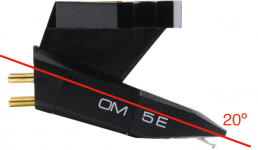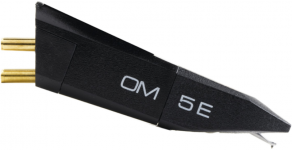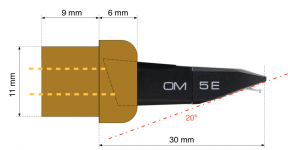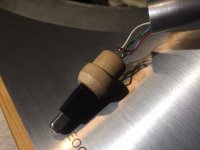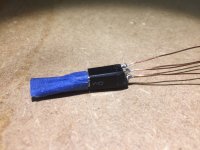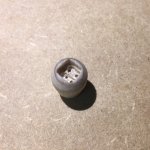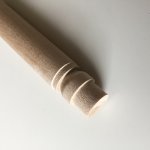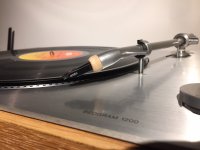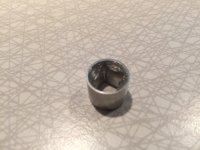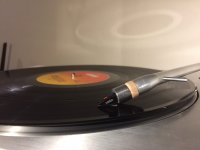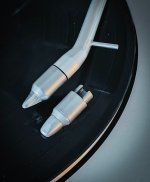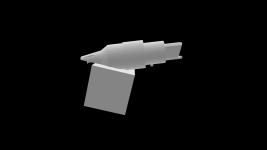I love vintage gear and I have a Beogram 1200 with a failing stylus suspension. The major drawback with the old Beograms is the B&O proprietary cartridges and stylus, the fact that B&O doesn't support them anymore, that even ridiculously expensive NOS might fail due to aged stylus suspension and the inability to replace the proprietary tonearm, BUT they sure are nice to look at. 🙂
Anyway, I use my Beogram 1200 almost daily so I really want a way to at least replace the stylus, but how to do that when there are no new ones, no one is rebuilding them, nothing else fit the cartridge and you can't replace the tonearm? Build your own replacement cartridge and stylus?
I know it's a crazy endeavor but I started to play with the idea. I'v done some minor changes to some of my vintage gear but I always make sure to save all original parts and also secure a way to reverse any modifications back to stock. How could I getaway with it on a Beogram 1200?
I started to search the net. Surely someone must have made something close to it right? But I came up with nothing, what a surprise! I didn't let that stop me and I am now documenting my effort in case anyone else search for something similar.
First up, what are the constraints? The Beogram 1200 tonearm is pre bent to some 20 degrees. It's a thin aluminum tube, 13 mm outer diameter and 11 mm inner diameter. The original cartridge is 30 mm long including stylus and it weight 7.5 gram.
My first thought was to make an adapter but the pre-bent arm makes it difficult, most cartridges are made to fit a straight arm and it would totally kill it aesthetically. Next thought was to find suitable donor, something that would fit good enough as a starting point.
The 20 degree pre-bent arm got me thinking about the old Ortofon Concorde and that thought led me to the Ortofon OM cartridge. It can be had for a reasonable amount of money with the 5E stylus and it's well supported with replacement styluses. I decided to give it a try and ordered one from Germany.
My plan was to take the Ortofon OM 5E as seen on image 1, take away everything except whats in image 2 and make something like image 3.
Anyway, I use my Beogram 1200 almost daily so I really want a way to at least replace the stylus, but how to do that when there are no new ones, no one is rebuilding them, nothing else fit the cartridge and you can't replace the tonearm? Build your own replacement cartridge and stylus?
I know it's a crazy endeavor but I started to play with the idea. I'v done some minor changes to some of my vintage gear but I always make sure to save all original parts and also secure a way to reverse any modifications back to stock. How could I getaway with it on a Beogram 1200?
I started to search the net. Surely someone must have made something close to it right? But I came up with nothing, what a surprise! I didn't let that stop me and I am now documenting my effort in case anyone else search for something similar.
First up, what are the constraints? The Beogram 1200 tonearm is pre bent to some 20 degrees. It's a thin aluminum tube, 13 mm outer diameter and 11 mm inner diameter. The original cartridge is 30 mm long including stylus and it weight 7.5 gram.
My first thought was to make an adapter but the pre-bent arm makes it difficult, most cartridges are made to fit a straight arm and it would totally kill it aesthetically. Next thought was to find suitable donor, something that would fit good enough as a starting point.
The 20 degree pre-bent arm got me thinking about the old Ortofon Concorde and that thought led me to the Ortofon OM cartridge. It can be had for a reasonable amount of money with the 5E stylus and it's well supported with replacement styluses. I decided to give it a try and ordered one from Germany.
My plan was to take the Ortofon OM 5E as seen on image 1, take away everything except whats in image 2 and make something like image 3.
Attachments
Last edited:
I contemplated a suitable material but ended up using a 14 mm birch dowel rod. I liked the idea of something in wood and it is quite easy to machine so I stuck it in the lathe and made a couple of what you find in image 1.
I lack a small enough coordinate table to I finished it off with a Dremel until it looked like image 2.
I had to take off the connectors sticking out at the wrong angle on what was left of the cartridge and I then soldered some solid copper wires on what was left of them, picture 3.
I desoldered the socket for the original cartridge and that left me with a hollow piece of the tonearm 11 mm in diameter and at least 9 mm long. I made my wooden adapter fit perfectly in the tone arm, glued what was left of the OM cartridge to the wooden adapter and soldered the tonearm wires to the trimmed copper wires from my butchered OM cartridge, picture 4.
I lack a small enough coordinate table to I finished it off with a Dremel until it looked like image 2.
I had to take off the connectors sticking out at the wrong angle on what was left of the cartridge and I then soldered some solid copper wires on what was left of them, picture 3.
I desoldered the socket for the original cartridge and that left me with a hollow piece of the tonearm 11 mm in diameter and at least 9 mm long. I made my wooden adapter fit perfectly in the tone arm, glued what was left of the OM cartridge to the wooden adapter and soldered the tonearm wires to the trimmed copper wires from my butchered OM cartridge, picture 4.
Attachments
Last edited:
It now started to look quite decent, it actually looked like it could work, image 1.
But it can't be that easy can it? The original cartridge weight 7.5 gram my "Francofon" weight only 3 gram and the B&O tonearm is very inflexible when it comes to adjust anything except weight of the original cartridge...
I took some tape and fastened a nut with the right weight (around 4 grams) to the arm just to try it out. It sounded perfectly but how could I fix this?
What I ended up doing was probably not the easiest route to take but it was quick. I took a plunge base router with a 13 mm router bit and routed a hole in a piece of MDF. I then fixed another piece of MDF under it and then poured a melted mixture of tin and led into this "mold". I then drilled a hole in the middle of this quite heavy piece of metal, and filed it by hand until it fit over the cartridge. It ended up just shy of 5 gram, picture 2.
Picture 3 is the final result. It works perfectly and I can now continue to use my Beogram 1200 AND buy cheap new styluses when needed. This was just a proof of concept and I will do it a bit differently if I ever have to replace the cartridge. I would probably fuse wood and metal and then machine it into a nicer shape on the lathe. I would also consider fusing metal and some black epoxy instead of wood. There are plenty of ideas in my head on how to do this better but I will now just kick back and enjoy some records on my newly modded Beogram 1200 😉
Ps. No original parts were harmed during this experiment.
But it can't be that easy can it? The original cartridge weight 7.5 gram my "Francofon" weight only 3 gram and the B&O tonearm is very inflexible when it comes to adjust anything except weight of the original cartridge...
I took some tape and fastened a nut with the right weight (around 4 grams) to the arm just to try it out. It sounded perfectly but how could I fix this?
What I ended up doing was probably not the easiest route to take but it was quick. I took a plunge base router with a 13 mm router bit and routed a hole in a piece of MDF. I then fixed another piece of MDF under it and then poured a melted mixture of tin and led into this "mold". I then drilled a hole in the middle of this quite heavy piece of metal, and filed it by hand until it fit over the cartridge. It ended up just shy of 5 gram, picture 2.
Picture 3 is the final result. It works perfectly and I can now continue to use my Beogram 1200 AND buy cheap new styluses when needed. This was just a proof of concept and I will do it a bit differently if I ever have to replace the cartridge. I would probably fuse wood and metal and then machine it into a nicer shape on the lathe. I would also consider fusing metal and some black epoxy instead of wood. There are plenty of ideas in my head on how to do this better but I will now just kick back and enjoy some records on my newly modded Beogram 1200 😉
Ps. No original parts were harmed during this experiment.
Attachments
Last edited:
Thank you Arch, it was well worth €30 (cost of the Ortofon OM 5E) and it only took a couple of hours to make (it was a fun project too). 🙂Very smart, wonderful idea.
Very nice and inventive, Emumannen! My compliments. There's a similar B&O deck sitting here on a shelf waiting patiently for a refurbishment. Fortunately, I have quite a few of those old cartridges and the means to repair them.
Regards
bulgin
Regards
bulgin
Thanks bulgin, is there a way to repair a failed stylus suspension on an original B&O "bullet" cartridge?Very nice and inventive ...
I have quite a few of those old cartridges and the means to repair them.
Regards / Rob
Hi EmuMannen,
Most impressive work, and thank you for proving that this is possible! Great inspiration.
I'm trying to copy the trick on my Beogram 1203 (mostly same design), although I'll be 3D-printing the adapter instead of powering up my lathe. One question up front: In IMG_1376 it looks like you've soldered the two returns (blue, green) together with the ground/earth cable. Is that correct, and is it recommendable? I know that blue/green are connected inside the turntable anyway, but the ground/earth is kept separate in the original design as well as on modern turntables and RIAAs. I'm rather inclined to assume that there's a good reason for that. Would you care to comment on that? Thanks.
Regards, Rasmus
Most impressive work, and thank you for proving that this is possible! Great inspiration.
I'm trying to copy the trick on my Beogram 1203 (mostly same design), although I'll be 3D-printing the adapter instead of powering up my lathe. One question up front: In IMG_1376 it looks like you've soldered the two returns (blue, green) together with the ground/earth cable. Is that correct, and is it recommendable? I know that blue/green are connected inside the turntable anyway, but the ground/earth is kept separate in the original design as well as on modern turntables and RIAAs. I'm rather inclined to assume that there's a good reason for that. Would you care to comment on that? Thanks.
Regards, Rasmus
Thanks for your kind words and for reminding me about this build. I want to go back and redo this work and I was also planning to 3D print, then make a silicon mold and finally cast it in metal.Hi EmuMannen,
Most impressive work, and thank you for proving that this is possible! Great inspiration.
I'm trying to copy the trick on my Beogram 1203 (mostly same design), although I'll be 3D-printing the adapter instead of powering up my lathe. One question up front: In IMG_1376 it looks like you've soldered the two returns (blue, green) together with the ground/earth cable. Is that correct, and is it recommendable? I know that blue/green are connected inside the turntable anyway, but the ground/earth is kept separate in the original design as well as on modern turntables and RIAAs. I'm rather inclined to assume that there's a good reason for that. Would you care to comment on that? Thanks.
Regards, Rasmus
The cables, I think I kept them as on the original design, blue and green apart but I can’t recall what I did with the ground wire? I remember doing a lot of research on different ways to connect the wires, pros and cons since the cartridge only has four pins and there is five wires counting ground. The original mount and cartridge got some metal where the ground wire is attached. I might have ended up soldering the ground wire either to blue, green or both. It is currently in my garage stacked in a plastic container (with a bunch of other, fully restores turntables). I will try to do an inspection if I manage to dig it out of the pile (I guess it’s in the bottom of one of the stacks)…
Don't go through too much trouble for the wiring. I believe a safe choice is to keep the ground to the tonearm only - isolated from the cartridge leads; I just wanted to hear, if you were certain of something else 🙂
I don't have equipment for molding/casting myself - sounds like a really nice solution. Is this something you'll be doing anytime soon? I'd be very happy to purchase a cast from you
I'm attaching my 3D model. Maybe it can be of help. I'm using Blender (mostly because I was familiar with Blender already before getting my first 3D-printer, and instead of learning a CAD program, I just stuck to what I knew). The cut-aways for the OM cartridge are currently with zero margin, so some adjustment of the model is necessary to make the cartridge fit in the hole - either in the design or mechanically after manufacturing. As that margin will depend on printer, material, technique, etc, I didn't want to apply it before uploading the file.
I don't have equipment for molding/casting myself - sounds like a really nice solution. Is this something you'll be doing anytime soon? I'd be very happy to purchase a cast from you
I'm attaching my 3D model. Maybe it can be of help. I'm using Blender (mostly because I was familiar with Blender already before getting my first 3D-printer, and instead of learning a CAD program, I just stuck to what I knew). The cut-aways for the OM cartridge are currently with zero margin, so some adjustment of the model is necessary to make the cartridge fit in the hole - either in the design or mechanically after manufacturing. As that margin will depend on printer, material, technique, etc, I didn't want to apply it before uploading the file.
Attachments
I thought I’d share a little update on a project I’ve been working on recently. I’m developing a production-quality adapter for SP-connected turntables, specifically for the Ortofon OM series cartridge. The goal is to create an adapter that matches the exact geometry and tracking force specifications of the OM series, with a tracking force between 1.5g and 2g.
I’ve designed the adapter to require only minimal modifications to the original turntable, making it easy to install while maintaining the authentic feel of the equipment. I’ve been testing it on Beogram 1202 and 3000 turntables, and the design follows the original style, including a transparent needle holder.
I’m not sure if this is the right place for a project like this, but I thought I’d share it here to gauge interest.
I’m planning to produce a small batch of 10-20 units to start with. If you’re interested, feel free to reach out via private message.
I’ve designed the adapter to require only minimal modifications to the original turntable, making it easy to install while maintaining the authentic feel of the equipment. I’ve been testing it on Beogram 1202 and 3000 turntables, and the design follows the original style, including a transparent needle holder.
I’m not sure if this is the right place for a project like this, but I thought I’d share it here to gauge interest.
I’m planning to produce a small batch of 10-20 units to start with. If you’re interested, feel free to reach out via private message.
The painting is complete, and I successfully matched the tonearm's original color. Now, I need to work on the tip section. Currently, it's painted in the same aluminum color, but I want it to be transparent.
We tested printing with clear filament, but the results were slightly cloudy. Next, I'll try wet-sanding the clear part's surface and applying a couple of coats of clearcoat. Hopefully, this will achieve the desired result.
Here's a quick teaser shot, adapter design vs the original.
What do you think? Any feedback on design?
We tested printing with clear filament, but the results were slightly cloudy. Next, I'll try wet-sanding the clear part's surface and applying a couple of coats of clearcoat. Hopefully, this will achieve the desired result.
Here's a quick teaser shot, adapter design vs the original.
What do you think? Any feedback on design?
Attachments
Amazing! Really interested. I've got a beogram 1200 that I love but stylus us dead and don't wanna put it away.
Really hope you can make some, I'll get one for sure!
Really hope you can make some, I'll get one for sure!
Hey everyone. I have been busy with other projects but finally got wiring done and cartidge on the test. I must say, it works perfectly!
Here's couple of images and videos.
Next week, I’ll be producing a limited batch of around 5 units for delivery. Feel free to reach out if you’re interested!
Video



Here's couple of images and videos.
Next week, I’ll be producing a limited batch of around 5 units for delivery. Feel free to reach out if you’re interested!
Video
Last edited:
Don't go through too much trouble for the wiring. I believe a safe choice is to keep the ground to the tonearm only - isolated from the cartridge leads; I just wanted to hear, if you were certain of something else 🙂
I don't have equipment for molding/casting myself - sounds like a really nice solution. Is this something you'll be doing anytime soon? I'd be very happy to purchase a cast from you
I'm attaching my 3D model. Maybe it can be of help. I'm using Blender (mostly because I was familiar with Blender already before getting my first 3D-printer, and instead of learning a CAD program, I just stuck to what I knew). The cut-aways for the OM cartridge are currently with zero margin, so some adjustment of the model is necessary to make the cartridge fit in the hole - either in the design or mechanically after manufacturing. As that margin will depend on printer, material, technique, etc, I didn't want to apply it before uploading the file.
is there anyone how have made the 3d print from RasmusHS I am a bit confused about the model
Attachments
Hi Noid77 (and anyone else interested),
The model I uploaded was work in progress with objects and cut-aways. From your picture it seems that you're showing all the objects at once, which won't make much sense. Let me upload a few pictures of the last version of the model and the final result, as well as STLs for the two parts that I ended up 3D-printing.
I went through a great deal of trouble getting the weight of the cartridge as close to the original as possible. The PLA doesn't get even close by itself, so I found a ferrite ring (L=10mm, Ø14mm, T=2mm) in a drawer and built the adapter around that (or rather trough it). The SP14 weighs 9.11 g (including the black plastic fitting that I couldn't remove from the arm without breaking it), and the replacement cartridge weighs 8.57 g, which is very much close enough.
As you can see I went through no trouble at all trying to match the original SP14 design. Let's call it "visible mending" .. supposed to be really hot these days. I also chose some wiring that turned out to be way too thick, meaning that it was downright impossible to get it past the handle-stud inside the tonearm. With the choice between on the one hand starting all over (having already epoxy'ed the adapter parts together and soldered the wires) or on the other hand removing the stud, I chose to sacrifice the stud. I don't regret the choice, but I do regret the wire thickness.
The attached STL files of the two separate adapter parts are printable. They include a bit of breakaway material to keep the parts more stable on the print plate. I used a 0.2 mm nozzle and 0.1 mm layer height to print them; the details are quite delicate so anything rougher than that is not likely to work well.
The result works flawlessly, and the Ortofon 5E pickup is easily replaceable on the OM cartridge.





The model I uploaded was work in progress with objects and cut-aways. From your picture it seems that you're showing all the objects at once, which won't make much sense. Let me upload a few pictures of the last version of the model and the final result, as well as STLs for the two parts that I ended up 3D-printing.
I went through a great deal of trouble getting the weight of the cartridge as close to the original as possible. The PLA doesn't get even close by itself, so I found a ferrite ring (L=10mm, Ø14mm, T=2mm) in a drawer and built the adapter around that (or rather trough it). The SP14 weighs 9.11 g (including the black plastic fitting that I couldn't remove from the arm without breaking it), and the replacement cartridge weighs 8.57 g, which is very much close enough.
As you can see I went through no trouble at all trying to match the original SP14 design. Let's call it "visible mending" .. supposed to be really hot these days. I also chose some wiring that turned out to be way too thick, meaning that it was downright impossible to get it past the handle-stud inside the tonearm. With the choice between on the one hand starting all over (having already epoxy'ed the adapter parts together and soldered the wires) or on the other hand removing the stud, I chose to sacrifice the stud. I don't regret the choice, but I do regret the wire thickness.
The attached STL files of the two separate adapter parts are printable. They include a bit of breakaway material to keep the parts more stable on the print plate. I used a 0.2 mm nozzle and 0.1 mm layer height to print them; the details are quite delicate so anything rougher than that is not likely to work well.
The result works flawlessly, and the Ortofon 5E pickup is easily replaceable on the OM cartridge.
Attachments
Id love to see something done for the 4000 series of beograms...- do we consider 3D printing a new arm tube (rectangular cross Section)
This might be a consideration in stead of hacking an original arm tube- but-- with the cost of replacemetn cartridges it may be an aoofrable way to bring these things back to life...
This might be a consideration in stead of hacking an original arm tube- but-- with the cost of replacemetn cartridges it may be an aoofrable way to bring these things back to life...
- Home
- Source & Line
- Analogue Source
- DIY replacement cartridge and stylus for a Beogram 1200
